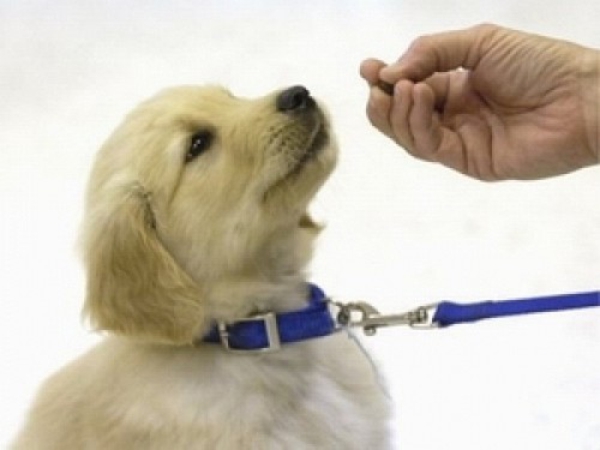While some puppies are born blind, other dogs will need to learn to cope as an adult with loss of eyesight due to age, illness or injury. Teaching a blind puppy the basic obedience commands will help keep him safe and instill confidence. Likewise, an adult dog with lost or worsening vision will need to relearn certain skills.

Create a safe and consistent living and training environment
Your dog cannot see that low hanging branch. He does not understand that there is now a new coffee table in the room that needs to be sidestepped. Keep obstacles to a minimum; and once something is in a certain place and your new puppy or adult dog is familiar with its placement, try to avoid rearranging the environment. If you must change something, or if you are introducing a blind puppy to a new setting, plan to conduct numerous walkthroughs so the dog can learn where things are located.
Be sure to include a place for pup, too. A pet pillow bed that catches the sun from a window, or a little nook in a corner away from noise and intrusion are welcomed safe spots for Fido to relax. You also always want to keep his food and water bowls in the same place. For your training setting in particular, select an area that is open and familiar.
Teach safety commands like “slow,” “wait” or “stop”
Often times we think of teaching “come” and “sit,” but being able to direct your dog’s movements from a distance can be key to keeping your blind pet safe. This is when verbal direction and speed commands become useful. You can start these even as you are performing your walkthrough of the house. While your dog is on a leash say “slow” as you approach an obstacle and slow your pace while applying a gentle pressure on the leash, too. This command comes in handy if your dog is about to bump into something. Keep in mind that the phrase “slow down” can be confusing if you intend to also teach a “down” or “lay down” command.
The command “wait” or “stop” is built upon “slow”. For example, you and your dog may “slow” as you approach an intersection and then “stop” or “wait” until the walk signal appears. This is taught the same way, just that you would come to a complete stop versus slowing. You may or may not want to teach the dog to sit in addition to the stop. You will also need to let the dog know verbally when it is ok to move again. This could be “heel,” “come,” “let’s go,” or anything you want it to be, but do try to make it fun and encouraging.
If your home or porch includes stairs, then teaching “steps” is also a useful safety command to avoid falls and injuries.
Appeal to your dog’s other senses
A blind puppy is going to need housebreaking, but even an adult dog who was previously trained can revert back to having accidents in the house if he is unsure how to ask to go outside.
Appeal to your dog’s other senses such as touch and smell for teaching this routine. Place a specific rug that your pup’s paws will recognize near the door. Try including a scent on the doggie door or rug, too.
There are many adjustments ahead for both you and your blind dog, but with the help of a loving owner, he will be getting around as well as a seeing dog soon enough.
Dr. Susan Wright DMV is a dedicated veterinarian that enjoys writing articles highlighting various aspects of dog training.
Training A Blind Dog

